What to Eat in Rome: A Local’s Food Guide to the Eternal City
Rome isn’t just about ancient ruins, baroque fountains, or bustling piazzas. To truly experience the Eternal City, you need to sit down at a trattoria table, sip an espresso at the counter, or wander into a busy market filled with seasonal produce. Roman cuisine is rooted in tradition: simple, hearty, and deeply tied to the rhythm of everyday life. This is a city where food isn’t rushed — it’s celebrated. In this guide, we’ll explore the must-try dishes, street foods, desserts, and drinks of Rome, plus where and how to enjoy them like a local.
ITALYROMECULINARY ADVENTURES
Prabah Gamage
19 min read

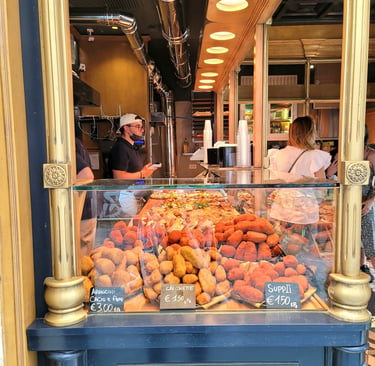
The Soul of Roman Cuisine: Simplicity and Tradition
Roman food is about bold flavors with minimal ingredients. Unlike northern Italian dishes rich with butter and cream, Roman recipes often rely on olive oil, pecorino cheese, cured pork (like guanciale), and seasonal vegetables. The cooking reflects the city’s working-class history — simple, affordable, and satisfying.
Golden rules of Roman food:
Less is more: A few high-quality ingredients make the dish.
Respect tradition: Locals value authenticity and time-honored recipes.
Eat seasonally: Artichokes in spring, mushrooms in autumn, chestnuts in winter.
The Four Legendary Roman Pastas
If there’s one culinary chapter you can’t skip in Rome, it’s pasta. Romans have elevated simplicity to an art form — and nowhere is that more evident than in their four legendary pasta dishes. Each recipe is centuries old, crafted from humble ingredients but perfected through balance and technique.
These four pastas — Cacio e Pepe, Carbonara, Amatriciana, and Gricia — define the soul of Roman cuisine. They share a common thread: Pecorino Romano cheese and guanciale (cured pork cheek), staples in nearly every Roman kitchen. But each has its own story, texture, and mood.
Let’s savor them one by one.
🍝 Cacio e Pepe: The Purist’s Pasta
Cacio e Pepe literally means “cheese and pepper,” and that’s exactly what it is — yet it’s also so much more.
The beauty of this dish lies in the technique: the salty bite of Pecorino Romano melts into hot pasta water to create a silky, peppery sauce that clings to every strand of spaghetti or tonnarelli. Done right, it’s creamy without cream, comforting yet bold, and a pure expression of Roman restraint.
📖 The Secret: The magic happens in the mixing. Too hot, and the cheese curdles; too cold, and it clumps. Romans use a splash of starchy pasta water to bind it perfectly.
🕰️ Fun Fact: This dish dates back to shepherds in the Roman countryside, who carried dried pasta, aged cheese, and black pepper — ingredients that could survive long days on the road.
🥓 Carbonara: The Quintessential Roman Indulgence
No dish sparks more debate than Carbonara. Purists insist on no cream, garlic, or onion — just egg yolks, Pecorino Romano, guanciale, and black pepper. The heat from the pasta emulsifies the egg and cheese into a luxurious, golden sauce that’s both silky and rich.
🍳 What Makes It Unique: The guanciale gives Carbonara its distinct flavor — deep, savory, and slightly smoky. Pancetta is sometimes substituted, but Romans will tell you: it’s just not the same.
📖 A Bit of History: Carbonara’s origins are humble — possibly linked to coal miners (carbonari) who needed quick, hearty meals. Another theory traces it to American soldiers after WWII who combined bacon and eggs with Italian pasta.
🍷 Perfect Pairing: A crisp white Frascati wine or a light red Cesanese complements the salty richness beautifully.
🍅 Amatriciana: Rome’s Fiery Red Classic
Named after the mountain town of Amatrice, this pasta combines the comfort of tomato sauce with the saltiness of guanciale and the sharp bite of Pecorino Romano. Traditionally served with bucatini (a hollow spaghetti that catches the sauce perfectly), it’s hearty, spicy, and quintessentially Roman.
🌶️ Flavor Profile: Smoky pork, bright tomatoes, and a gentle chili kick — the holy trinity of balance.
📜 Origin Story: Amatriciana started as a tomato-free dish (Gricia) and evolved when tomatoes arrived in Italy in the 17th century. The addition turned it into a national icon.
💡 Tip: Real Amatriciana uses guanciale — never bacon or pancetta — and San Marzano tomatoes for authenticity.
🧄 Gricia: The Forgotten Ancestor
Often called the “white Amatriciana,” Gricia is a minimalist’s dream — pasta tossed with crispy guanciale, Pecorino Romano, and black pepper. Without tomato sauce, its flavors are concentrated and comforting.
🍽️ Why You’ll Love It: Gricia highlights the full flavor of guanciale and cheese — it’s the closest you’ll get to tasting the essence of Roman tradition.
📖 Historic Roots: Some say Gricia was born in the countryside near Amatrice before tomatoes arrived from the New World. It was the shepherd’s everyday meal — rich, filling, and made from pantry staples.
📍 Where to Try the Legendary Roman Pastas
🍽️ Roscioli (near Campo de’ Fiori)
A Roman institution that bridges fine dining and tradition. Their Carbonara is world-famous — creamy, peppery perfection served in a wine-bar-meets-trattoria setting.
🍽️ Trattoria Da Enzo al 29 (Trastevere)
Beloved by locals and visitors alike, this cozy trattoria serves all four pastas in their purest forms. Expect a wait, but the reward — a plate of hot, glossy Cacio e Pepe — is worth it.
🍽️ Flavio al Velavevodetto (Testaccio)
Housed in an ancient Monte Testaccio cave, this spot is as Roman as it gets. Their Amatriciana and Gricia are textbook examples of how simplicity can taste like art.
💡 Slow Travel Tip: Order one pasta per meal and alternate across your trip — that way, you’ll taste all four without feeling rushed.
✨ In Essence
The four Roman pastas are more than dishes — they’re a language, a way of expressing the city’s culinary identity. Mastering the difference between them is like learning to speak Rome’s native tongue.
If you only have time for one? Make it Carbonara. But if you’re truly savoring Rome, you’ll find yourself planning your days around tasting all four. Each bite tells a story — and together, they tell the story of Rome itself.

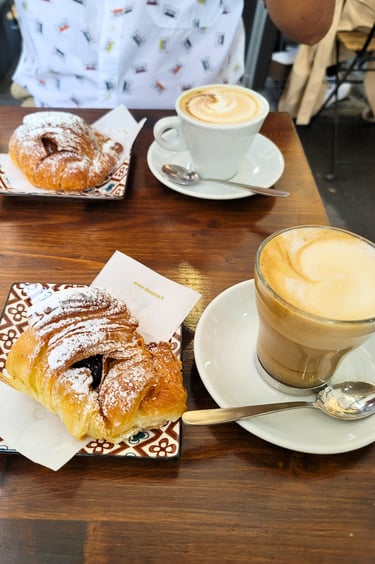
Roman Street Food: Grab-and-Go Classics
Rome is a city best experienced on foot — wandering through cobblestone alleys, crossing sun-drenched piazzas, and stumbling upon small bakeries and hole-in-the-wall snack bars serving some of the most delicious food in Italy. Street food here isn’t a passing trend; it’s a centuries-old tradition.
Romans have always embraced eating on the go — from ancient bread vendors at the Forum to today’s busy locals grabbing a slice between meetings. The magic lies in how simple these foods are, yet how deeply satisfying they taste.
Here are the must-try Roman street foods that turn an ordinary walk into a culinary adventure.
🍕 Pizza al Taglio — Pizza by the Slice, Roman Style
Forget what you know about round, sit-down pizzas. In Rome, pizza al taglio (“by the slice”) is the people’s pizza — rectangular, baked in large trays, and sold by weight. You’ll find it everywhere: from humble corner bakeries to gourmet pizzerias experimenting with seasonal toppings.
The Roman style is defined by its crust: thin, airy, and perfectly crisp on the bottom. Each square can be topped with almost anything — from creamy burrata and fresh tomatoes to roasted potatoes, zucchini blossoms, or paper-thin mortadella.
💡 Slow Travel Tip: Order a few small slices with different toppings and eat them standing at the counter like the locals do.
📍 Where to Try:
Pizzarium Bonci (near Vatican City): Run by celebrity chef Gabriele Bonci, this is the holy grail of Roman pizza al taglio. Expect inventive toppings and pillowy, fermented dough.
Alice Pizza: Found across the city, it’s a reliable favorite for classic flavors like margherita and capricciosa.
Forno Campo de’ Fiori: A historic bakery near the piazza, perfect for a slice and people-watching.
🍙 Supplì — Rome’s Irresistible Fried Rice Balls
If Rome had a signature street snack, supplì would be it. These golden, crispy croquettes are filled with risotto-style rice, ragù (meat sauce), mozzarella, and then deep-fried until the outside crackles and the inside stretches into cheesy perfection.
They’re sometimes called “supplì al telefono” because when you break one open, the stringy mozzarella looks like a telephone cord — a charming Roman metaphor that stuck.
Supplì are sold in bakeries, snack bars (tavola calda), and even high-end eateries. They’re the ultimate comfort food — portable, affordable, and deeply Roman.
📍 Where to Try:
Supplizio (Via dei Banchi Vecchi): Entirely dedicated to supplì, this chic little shop reimagines tradition with creative twists like carbonara or cacio e pepe filling.
Trapizzino (Trastevere): Famous for its namesake sandwich, but the supplì here are also top-tier.
Mercato Testaccio: A great spot to sample multiple vendors’ versions.
🥪 Trapizzino — The Modern Roman Icon
Invented in 2008, the Trapizzino is a modern street food phenomenon — a pocket of pizza bianca (Roman flatbread) sliced into a triangle and stuffed with beloved traditional recipes like chicken cacciatora, meatballs in tomato sauce, or eggplant parmigiana.
It’s the perfect blend of old and new — Roman comfort food, reimagined for eating on the go. The bread is crisp on the outside, soft inside, and the fillings are pure nostalgia.
💡 Tip: Trapizzino shops often serve craft beer and local wines, making them ideal for an easy, casual lunch or aperitivo.
📍 Where to Try:
Trapizzino Trastevere: The original shop that started it all. Always busy, always delicious.
Mercato Centrale Roma (Termini Station): Grab one before catching your train north to Florence.
🌿 Carciofi alla Giudia — Fried Artichokes from the Jewish Ghetto
In spring, when artichokes are in season, Rome’s Jewish Quarter transforms into a temple of fried perfection. Carciofi alla Giudia (“Jewish-style artichokes”) are whole artichokes fried twice until their leaves open like golden flowers. The outer leaves are crispy like chips, while the heart stays tender and flavorful.
This ancient recipe dates back to the Roman Jewish community of the 16th century and remains one of the city’s most beloved dishes. You’ll find it in restaurants, markets, and takeaway counters.
📍 Where to Try:
Da Giggetto al Portico d’Ottavia: An institution for Roman-Jewish cuisine.
Nonna Betta: Another favorite for authentic fried artichokes and hearty Roman fare.
💡 Slow Travel Tip: Plan your visit in March or April, when local artichokes are in season. Pair them with a glass of white Frascati wine and eat outside for the full experience.
🧀 Pizza Bianca — The Humble Hero of Roman Bakeries
Sometimes the simplest things are the best. Pizza bianca (“white pizza”) isn’t topped with sauce or cheese — just olive oil, salt, and sometimes rosemary. Soft yet slightly chewy, it’s more like Roman focaccia and often eaten as a snack or sandwich bread.
Locals love it plain or stuffed with mortadella, prosciutto, or fresh mozzarella. You’ll see kids eating it after school, office workers grabbing it mid-morning, and bakers pulling trays out fresh from the oven all day long.
📍 Where to Try:
Forno Roscioli (Via dei Chiavari): Famous for its pizza bianca and pastries.
Antico Forno Roscioli Pietro: Another gem where you can grab a warm slice right from the oven.
💡 Insider Tip: The perfect pairing? Pizza bianca with mortadella — salty, creamy, and divine.
🍤 Fritti — The Art of Fried Street Snacks
Romans are masters of frying — from zucchini blossoms stuffed with anchovies and mozzarella (fiori di zucca) to cod fillets (baccalà fritto). These crispy bites are a cornerstone of the city’s street food scene, especially around Campo de’ Fiori and Testaccio.
If you see a stand selling fritti, stop. It’s one of the best ways to taste Rome’s casual side.
📍 Where to Try:
Dar Filettaro a Santa Barbara: Famous for its baccalà fritto — crispy fried cod wrapped in paper.
Mercato Centrale: Several vendors specialize in seasonal fritti and Roman comfort food.
🚶♀️ Slow Travel Tip: Turn Street Food into a Walking Feast
Skip the sit-down lunch one day and turn your exploration into a progressive street food adventure. Start at the Testaccio Market with a Trapizzino, walk toward Trastevere for supplì and pizza al taglio, and finish with gelato by the Tiber.
You’ll eat like a local, avoid crowds, and experience the city’s flavor one bite (and one neighborhood) at a time.
✨ In Essence
Roman street food is a reflection of the city itself — ancient yet inventive, chaotic yet comforting. Whether you’re munching on a crispy supplì or savoring artichokes fried to perfection, you’re tasting the heart of everyday Rome.
The best part? You don’t need reservations or a fancy table. Just curiosity, an empty stomach, and the willingness to eat your way through the Eternal City one delicious step at a time.
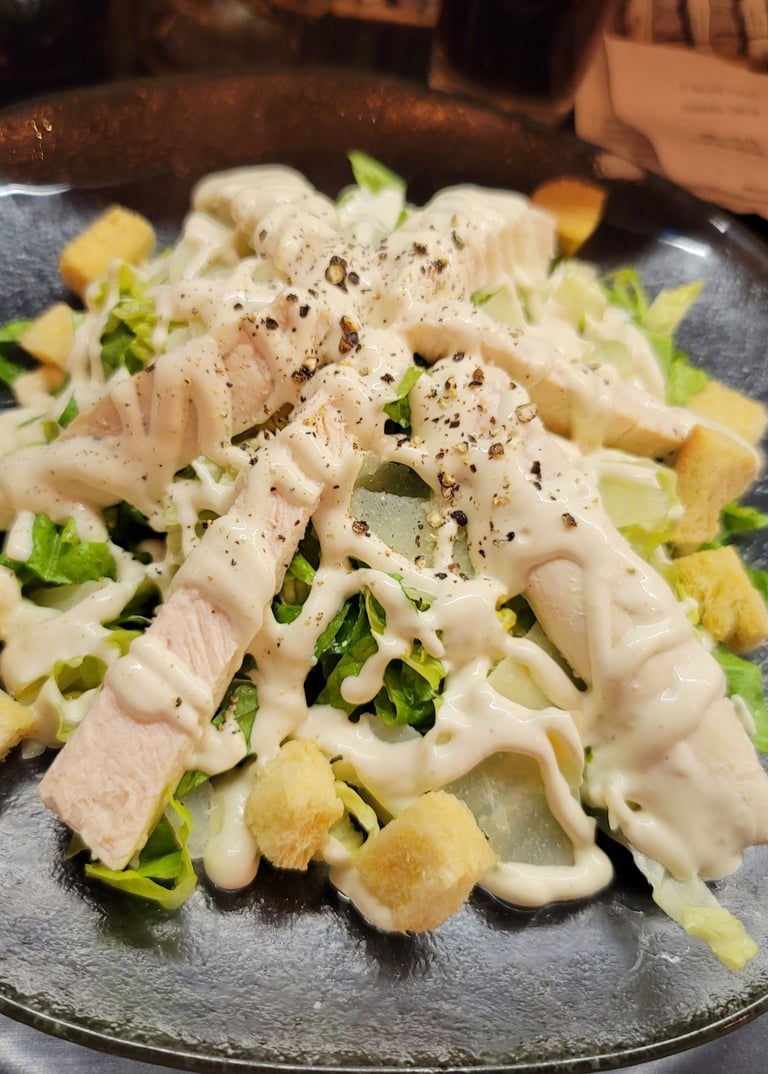

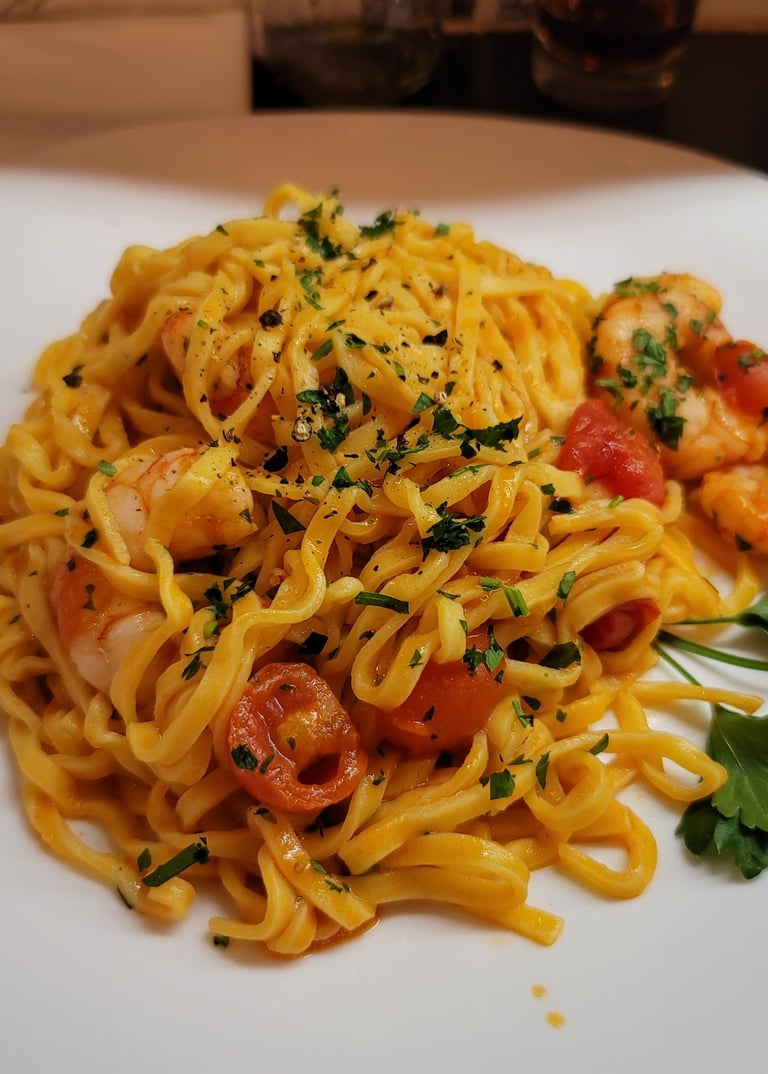

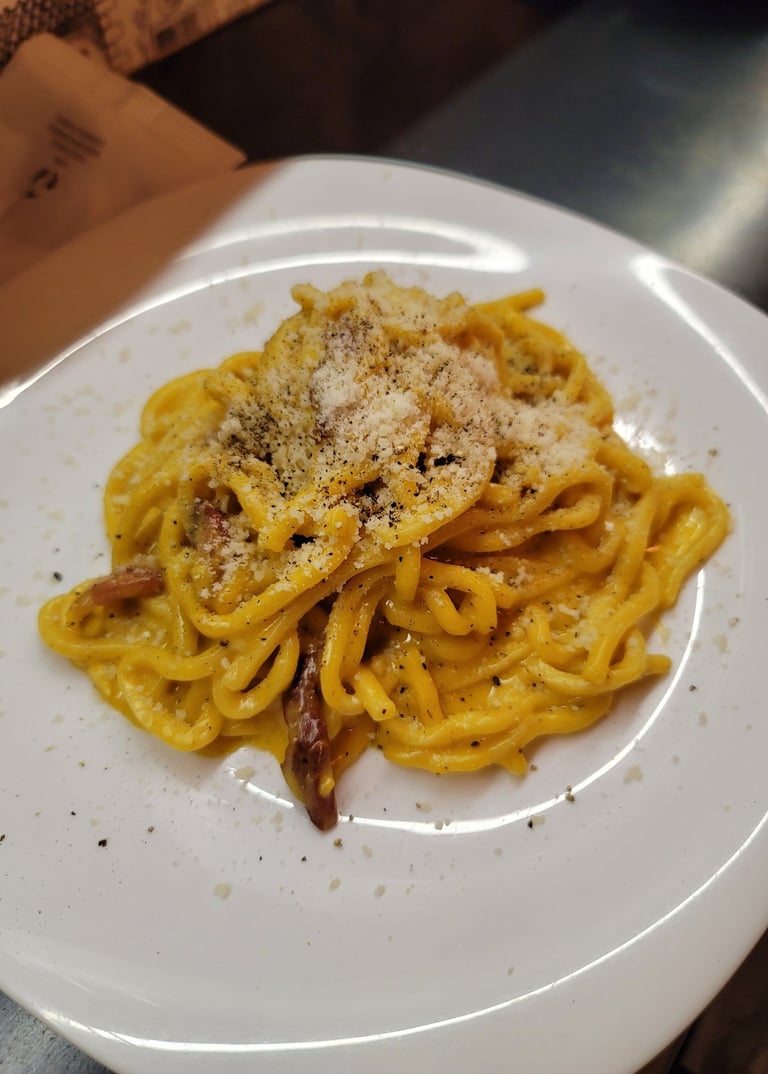

Market Life: Eating Like a Roman at the Source
To understand Roman food, you have to go where it begins — the markets.
For locals, markets aren’t just places to shop; they’re social rituals, morning gatherings, and culinary classrooms all in one. Farmers, fishmongers, bakers, and butchers greet their regulars by name. The air hums with chatter, laughter, and the scent of ripe tomatoes, fresh herbs, and espresso drifting from nearby stands.
This is la vera Roma — the real Rome — where food isn’t packaged and sterile but alive, colorful, and deeply personal.
Exploring Rome’s markets is the ultimate slow travel experience: you don’t just taste the city; you meet it.
Here are the markets where you can eat, shop, and savor like a true Roman.
🧺 Campo de’ Fiori: The Historic Heartbeat of Rome
Just steps from Piazza Navona, Campo de’ Fiori is one of Rome’s oldest open-air markets, operating since the 1800s. The name means “Field of Flowers,” a nod to its colorful past when the square was literally covered in blooms.
Today, it’s a vibrant mix of locals buying produce and visitors marveling at the chaos of Roman life in motion. Stalls overflow with artichokes, sun-dried tomatoes, fresh basil, and piles of citrus. You’ll also find vendors selling truffle oils, handmade pasta, olive wood spoons, and herbs packaged to take home as souvenirs.
💡 Slow Travel Tip: Go early — around 8 or 9 a.m. — before the crowds arrive. Mornings are when locals do their real shopping, and you’ll hear the lyrical rhythm of Italian banter in full swing.
📍 Don’t Miss:
Seasonal Roman artichokes in spring.
Bottarga (cured fish roe) and Pecorino Romano from local cheesemongers.
A cappuccino at Caffè Farnese, just beside the square, for a perfect people-watching perch.
🍅 Mercato di Testaccio: The Soul of Roman Food Culture
If you want to experience the authentic, everyday Rome, head to the Testaccio Market — part traditional food market, part modern foodie hub.
Located in a district that once housed the city’s slaughterhouses, Testaccio has always been the working-class heart of Roman cuisine. The market was reborn in a bright, contemporary space filled with about 100 stalls — some selling local produce, others serving incredible ready-to-eat meals.
Here, you’ll find nonna-style dishes and contemporary twists side by side. Locals come for groceries, and food lovers come for the atmosphere.
📍 What to Eat:
Mordi e Vai: Legendary panini stuffed with slow-cooked Roman classics like trippa alla romana (tripe) or bollito di manzo (boiled beef).
Le Mani in Pasta: Handmade pasta made fresh in front of you — try the carbonara-to-go.
CasaManco: Gourmet pizza al taglio with organic toppings.
Arancia Blu: Vegetarian Roman dishes with creative flair.
💡 Travel Tip: The market closes around 2:30 p.m., so go for brunch or lunch.
🎨 Why You’ll Love It:
The mix of traditional and modern captures exactly what Rome is — rooted in the past but never stuck there. You can nibble on artisanal cheeses while watching a barista whip up cappuccinos for the fishmongers next door.
🐟 Mercato Trionfale: Rome’s Biggest and Most Local Market
Located near the Vatican, Mercato Trionfale is massive — with more than 270 stalls under one roof — and it’s where real Romans shop. You won’t find many tourists here, which is exactly why it’s special.
This market is all about quality ingredients and local life. You’ll see grandmothers haggling over swordfish, priests buying vegetables after morning mass, and school kids stopping for fresh pastries.
📍 What to Try:
Seafood stalls: Daily catch from the Tyrrhenian Sea.
Cheese counters: Sample Pecorino Romano, ricotta fresca, and buffalo mozzarella.
Bakery stalls: Grab pizza bianca or sweet crostate for breakfast on the go.
💡 Local Insight: It’s cash-friendly, so bring euros — some vendors don’t take cards.
🌿 Other Markets Worth a Visit
Mercato Centrale (Roma Termini Station)
A modern food hall inside Termini Station. It’s sleek, bustling, and filled with top-tier vendors offering pasta, wine, pastries, and regional specialties. Ideal for a quick gourmet bite between trains.
📍 Try: Bonci pizza, Trapizzino, or freshly made pasta at La Pasta Fresca.
Mercato Monti (Weekend Market)
If you love vintage, design, and artisanal goods, the Monti neighborhood has a chic weekend market blending food and fashion. It’s the perfect stop before a cappuccino in one of Monti’s cozy cafes.
✨ In Essence
Rome’s markets are where the city’s true culinary heartbeat lives. They remind you that food isn’t something to rush through — it’s a conversation, a connection, and an everyday celebration.
So next time you’re in Rome, skip the supermarket and spend a morning where the locals do. Let the vendors teach you a few Italian words, taste a tomato that actually tastes like sunshine, and understand why Romans will forever say:
“La vita è troppo breve per mangiare male.”
(Life’s too short to eat badly.)
Roman Drinks: What to Sip with Your Meal
In Rome, what you drink is as important as what’s on your plate. Meals unfold slowly, each stage accompanied by a different sip — from the morning cappuccino to the evening amaro. Romans don’t drink to get drunk; they drink to enhance flavor, conversation, and connection.
Whether it’s a crisp white wine with fried artichokes, an Aperol spritz by the Tiber, or a tiny espresso standing at the bar, every beverage plays its role in the symphony of Roman dining.
Here’s how to sip like a local — one glass at a time.
☕ Morning Ritual: The Art of Italian Coffee
Coffee in Rome isn’t just caffeine — it’s a ceremony. Italians treat coffee as a quick, joyful pause, not a to-go necessity. You won’t see locals strolling with paper cups; instead, they gather at the counter, exchange a few words, and savor the moment.
☀️ How Romans Do Coffee:
Cappuccino: Morning only! A milky breakfast drink paired with a cornetto (Italian croissant). Order after 11 a.m. and you’ll get a raised eyebrow.
Espresso (Caffè): Short, strong, and served in a small cup — the Roman fuel for every hour of the day.
Caffè Macchiato: Espresso “stained” with a touch of milk foam.
Caffè Lungo: A slightly longer espresso for a less intense flavor.
Caffè Freddo: Sweetened iced espresso, popular in summer.
💡 Local Tip: Pay first, then take your receipt (scontrino) to the counter before ordering.
📍 Where to Sip:
Sant’Eustachio Il Caffè (near the Pantheon) – iconic Roman espresso with a secret blend.
Tazza d’Oro – a favorite for locals who swear by its strong, aromatic brew.
Roscioli Caffè Pasticceria – combines great coffee with pastries worth lingering over.
🥂 Aperitivo: Rome’s Golden Hour
As the afternoon fades into evening, Rome slows down for one of its most beloved rituals — the aperitivo.
Think of it as Italy’s version of happy hour, but infinitely more elegant. Around 6 or 7 p.m., cafés and bars set out small plates of snacks — olives, bruschetta, or mini panini — meant to accompany your drink and whet your appetite for dinner.
🍹 Classic Aperitivo Drinks:
Aperol Spritz: Bright orange, bittersweet, and bubbly — Aperol, Prosecco, and soda water over ice.
Campari Spritz: Slightly more bitter and complex than Aperol.
Negroni: Equal parts gin, Campari, and sweet vermouth. Invented in Florence but adored in Rome.
Hugo: A northern twist with elderflower liqueur, mint, and Prosecco — refreshing in summer.
💡 Slow Travel Tip: Order your aperitivo near sunset. Try the Zattere promenade, Piazza Navona, or a rooftop terrace overlooking the city. The view makes the spritz sparkle even more.
📍 Where to Go:
Freni e Frizioni (Trastevere): Trendy bar with a generous aperitivo spread and artistic crowd.
Terrazza Borromini: A rooftop bar near Piazza Navona with stunning views.
Il Goccetto: A cozy wine bar in Campo de’ Fiori — perfect for a glass of Frascati before dinner.
🍷 Wines of Rome and Lazio: A Taste of the Countryside
While Tuscany and Piedmont may dominate wine fame, the Lazio region surrounding Rome has its own treasures — crisp whites, earthy reds, and light sparkling varieties that pair beautifully with the city’s cuisine.
🍇 Wines to Try:
Frascati Superiore (White): Light, dry, and slightly fruity — a favorite Roman pairing with fried foods and pasta dishes like Cacio e Pepe.
Cesanese del Piglio (Red): Smooth and spicy, perfect with Amatriciana or Carbonara.
Nero Buono: A rare red variety from Cori, offering dark fruit notes and balanced acidity.
Malvasia Puntinata (White): Aromatic and floral — often served as an aperitif wine.
Castelli Romani DOC: A blended table wine, easy-drinking and found in many trattorias.
🍷 Pairing Tip: Romans match wine to food by contrast — a bright white to cut through rich cheese sauces, or a soft red to complement savory pork dishes.
📍 Where to Sip:
Trimani Enoteca: Rome’s oldest wine shop and bar, dating back to 1821.
Il Vinaietto: A lively neighborhood wine bar near Campo de’ Fiori.
Enoteca Ferrara: Elegant setting in Trastevere for serious wine lovers.
🍋 After Dinner: Digestivi, Amaro & Nightcaps
Dinner in Rome isn’t complete without something to aid digestion — a digestivo. These herbal liqueurs and sweet spirits mark the end of a good meal and are enjoyed slowly, often while lingering at the table.
🌿 Digestivi to Try:
Limoncello: Sweet, zesty lemon liqueur from southern Italy, served ice cold.
Amaro: A bittersweet herbal spirit — complex, aromatic, and uniquely Italian. Each region has its own version. Try Amaro Lucano, Averna, or Fernet Branca.
Sambuca: An anise-flavored liqueur often served with three coffee beans (con la mosca) symbolizing health, happiness, and prosperity.
Grappa: A strong spirit distilled from grape skins — fiery, fragrant, and best in small doses!
💡 Local Etiquette: Sip slowly — digestivi aren’t shots. Italians linger over them while chatting, laughing, or simply watching life go by.
📍 Where to Try:
Caffè Propaganda: Stylish bar near the Colosseum offering a refined amaro selection.
La Zanzara (Prati): Popular for post-dinner cocktails and digestifs.
Jerry Thomas Speakeasy: For a hidden, 1920s-style cocktail experience (reservations required).
🍸 Modern Mixology Meets Tradition
Rome’s cocktail scene is thriving, blending classic Italian ingredients with contemporary flair. Many bars now reinvent old favorites — using local herbs, craft vermouths, and even Roman honey or olive oil.
The Court (Palazzo Manfredi): Sip a craft cocktail overlooking the Colosseum — one of the most cinematic drink experiences in Rome.
Drink Kong: A futuristic bar in Monti, ranked among the world’s best, where mixology meets art.
Caffè Della Pace: Timeless and romantic, perfect for a nightcap in the historic center.
✨ In Essence
Roman drinks are more than beverages — they’re time markers in the Italian day. Each one sets the rhythm of life: the espresso that fuels the morning, the spritz that signals sunset, the wine that complements conversation, and the amaro that closes the night.
To sip like a Roman is to live like one — slowly, joyfully, and always in good company.
Sweet Temptations: Roman Desserts & Gelato
If Rome’s pasta is its soul, then its desserts are its poetry — simple, seasonal, and full of heart. Romans don’t need elaborate patisserie to impress; their sweets celebrate tradition, texture, and balance. Whether it’s a creamy gelato on a summer afternoon, a maritozzo with morning coffee, or a spoonful of tiramisu after dinner, dessert in Rome is more than an ending — it’s a ritual.
Let’s wander through the Eternal City one sweet bite at a time.
🍦 Gelato — Italy’s Coolest Obsession
No trip to Rome is complete without gelato, the cold, creamy cousin of ice cream — only richer, denser, and far more flavorful.
The difference lies in the process: gelato uses more milk than cream, churns slower, and is served at a slightly warmer temperature. This means intense flavor and smooth texture without the heavy, fatty feel of ice cream.
🍨 Flavors to Try:
Pistachio (Pistacchio di Bronte): Creamy, nutty perfection from Sicilian pistachios.
Stracciatella: Creamy base with ribbons of dark chocolate.
Hazelnut (Nocciola): Velvety and deeply roasted.
Tiramisu: The dessert turned into gelato form — coffee, mascarpone, cocoa.
Seasonal Fruit Sorbets: Fresh, tangy, and dairy-free — melon, lemon, or fig in summer.
💡 How to Spot Real Gelato:
Avoid bright neon colors or mountains piled high in the display. Authentic gelato is stored in covered metal tins and has muted, natural tones.
📍 Best Gelaterias in Rome:
Gelateria del Teatro (Via dei Coronari): Famous for creative, artisanal flavors like lavender and white chocolate basil.
Giolitti (Near the Pantheon): A historic gem since 1900 — elegant, traditional, and always bustling.
Fatamorgana: Known for all-natural ingredients and innovative combinations like pear-gorgonzola.
Gelateria dei Gracchi: Beloved by locals for rich, authentic flavors.
💡 Slow Travel Tip: Order two or three flavors in a small cup and enjoy them while strolling through a piazza. Eating gelato is a Roman art form — it’s meant to be savored, not rushed.
🍰 Maritozzo — Rome’s Sweet Breakfast Ritual
Before cappuccino culture took over, Romans started their day with maritozzo, a sweet brioche bun split open and filled with whipped cream. Soft, airy, and subtly sweet, it’s the kind of pastry that feels both indulgent and comforting.
The name maritozzo comes from “marito” (husband) — legend says men once gifted these buns to their fiancées with hidden jewelry or love notes tucked inside. Romantic, right?
💡 When to Eat It: Breakfast or mid-morning snack — always paired with cappuccino.
📍 Where to Try:
Il Maritozzaro (Trastevere): A local institution serving the city’s most famous maritozzo since the 1960s.
Roscioli Caffè Pasticceria: Elegant version with perfectly whipped cream.
Pasticceria Regoli (Esquilino): Historic pastry shop still using traditional recipes.
💡 Travel Tip: Order one maritozzo and two spoons — it’s the perfect pastry to share.
🍮 Tiramisù — Italy’s Most Beloved Dessert
Though it originated in northern Italy, tiramisu has become a staple in Rome’s trattorias. Translating to “pick me up,” it’s a luscious mix of espresso-soaked ladyfingers, mascarpone cream, cocoa powder, and sometimes a hint of liqueur.
Each spoonful is a little cloud of coffee-scented heaven — rich but not heavy, creamy but not cloying.
📍 Where to Try:
Pompi (Multiple Locations): Often called “The King of Tiramisu,” with classic and creative flavors (pistachio, strawberry, banana-chocolate).
Two Sizes (Via del Governo Vecchio): Specializes in tiramisu served in mini cups — adorable and delicious.
ZUM (Piazza del Teatro di Pompeo): Modern twist on the classic with customizable options.
💡 Slow Travel Tip: Try tiramisu in the afternoon with a macchiato — Romans often enjoy sweets with coffee instead of dessert wine.
🥧 Crostata di Ricotta e Visciole — The Jewish-Roman Classic
One of Rome’s oldest desserts comes from its Jewish Quarter — the Crostata di Ricotta e Visciole, or ricotta and sour cherry tart.
It’s simple yet divine: a buttery pastry crust filled with creamy sheep’s milk ricotta and tangy cherry jam. The flavor balance is perfection — sweet, tart, and slightly savory from the cheese.
📜 A Bit of History:
During centuries when dairy was restricted for Jewish communities, creative bakers found ways to adapt — combining what was available to create something timeless. The result is now a Roman institution.
📍 Where to Try:
Boccione Bakery (Via del Portico d’Ottavia): Hidden in the Jewish Ghetto, this no-frills bakery is legendary. Their tarts come out of the oven dark, rustic, and absolutely perfect.
Pasticceria il Boccione: (same family) – small, unmarked, always worth the wait.
💡 Tip: Go in the morning — by afternoon, they’re often sold out.
🍫 Other Roman Sweets Worth Trying
Cannoli (Sicilian import with Roman flair):
Crispy pastry tubes filled with sweet ricotta cream. You’ll find them in many Roman pasticcerie — sometimes dipped in pistachios or chocolate chips.
Tartufo:
A decadent gelato “truffle” made of chocolate and hazelnut, often with a cherry or cream center. Served frozen, it’s part gelato, part dessert showpiece.
📍 Try: Tre Scalini in Piazza Navona — the birthplace of the original Tartufo.
Crostata di Marmellata:
A rustic jam tart often made at home, found in cafes and bakeries. Perfect with an afternoon espresso.
Pangiallo:
A spiced Christmas treat made with honey, nuts, and candied fruits — ancient and symbolic, dating back to Imperial Rome.
✨ In Essence
Roman desserts aren’t flashy; they’re honest, nostalgic, and irresistible. They speak to the city’s soul — made from humble ingredients, perfected over generations, and always meant to be shared.
Whether you’re enjoying a maritozzo for breakfast, tasting ricotta tart in the Jewish Ghetto, or letting pistachio gelato melt slowly on your tongue as you stroll through Piazza Navona at sunset — you’re not just eating dessert. You’re experiencing the sweetest side of la dolce vita.
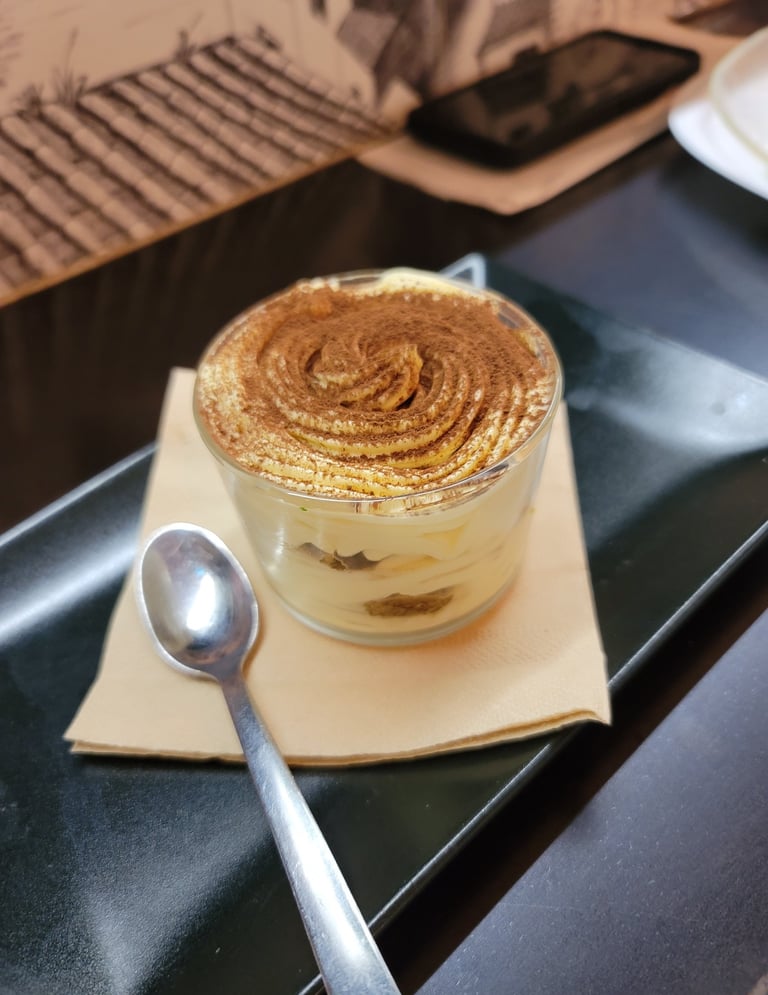

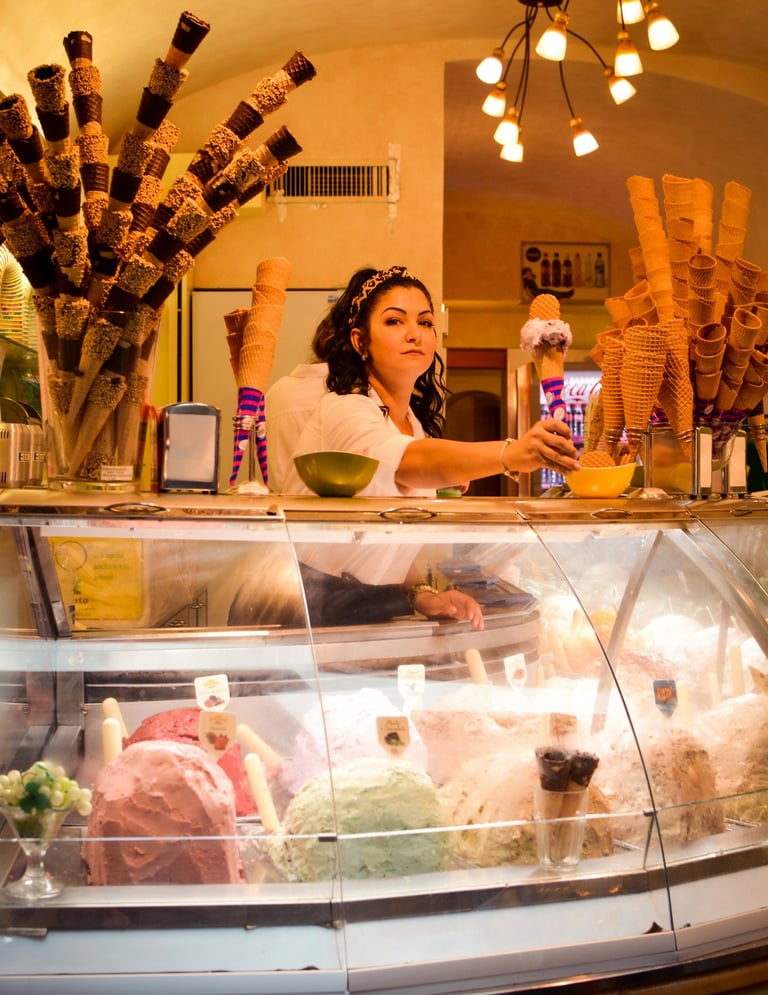

How to Eat Like a Local in Rome
✅ Avoid tourist traps: Skip menus with pictures or hosts calling you in.
✅ Eat late: Romans dine after 8 p.m.
✅ Look for “Trattoria” or “Osteria” instead of big ristorantes.
✅ Seasonal eating: Order what’s fresh and in season.
✅ Savor the pace: Meals are meant to be enjoyed slowly.
Rome on a Plate
Food in Rome is more than sustenance — it’s a cultural experience, a history lesson, and a love letter to the city itself. Whether you’re twirling spaghetti carbonara in Trastevere, biting into a crispy supplì on the go, or sipping an espresso in a sunlit piazza, you’re not just eating. You’re becoming part of the Eternal City’s rhythm.
So, come hungry — and leave with Rome forever on your palate.
A Sample Foodie Day in Rome
Morning: Cappuccino + cornetto at a café counter
Lunch: Cacio e Pepe at a trattoria in Trastevere
Afternoon snack: Supplì from a street vendor
Aperitivo: Aperol Spritz + cicchetti near Campo de’ Fiori
Dinner: Bucatini all’Amatriciana with local wine
Dessert: Gelato at Giolitti
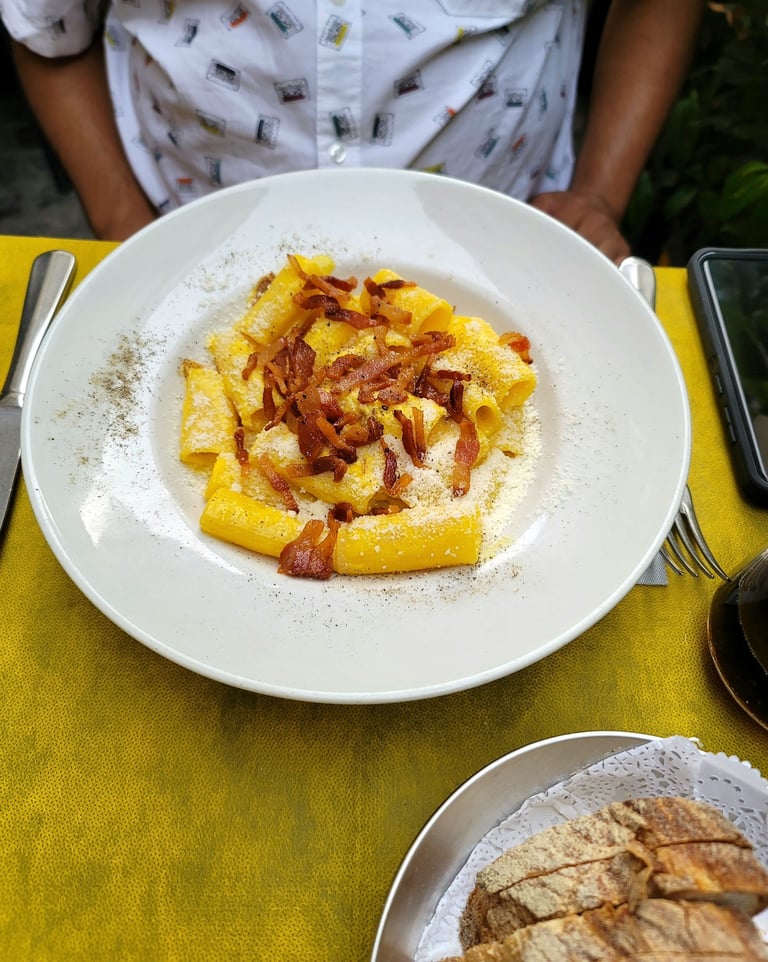

🔗 Related Blog Posts
It's Time to Travel Differently
You don’t need to quit your job or become a digital nomad to live more meaningfully. You just need a shift — in mindset, in pace, in how you connect. Let Explore Savor Thrive be your guide to more soulful travel, more memorable meals, and a more intentional life.
Welcome to the journey. We are so glad you're here!

Explore cultures, landscapes, and flavors of life.
© Expore Savor & Thrive 2025 - All Rights Reserved - Photography and Written Content Cannot be Reproduced.
